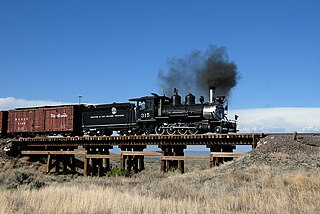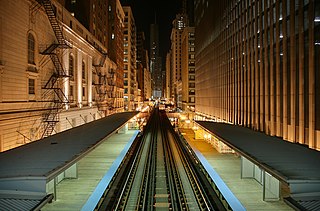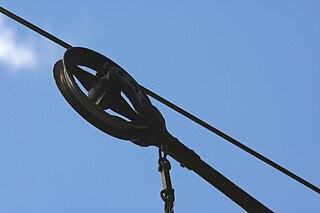Trolley may refer to:
Trolley may refer to:

A tram is an urban rail transit in which vehicles, whether individual railcars or multiple-unit trains, run on tramway tracks on urban public streets; some include segments on segregated right-of-way. The tramlines or tram networks operated as public transport are called tramways or simply trams/streetcars. Because of their close similarities, trams are commonly included in the wider term light rail, which also includes systems separated from other traffic.

Light rail is a form of passenger urban rail transit that uses rolling stock derived from tram technology while also having some features from heavy rapid transit.

A trolleybus is an electric bus that draws power from dual overhead wires using spring-loaded trolley poles. Two wires, and two trolley poles, are required to complete the electrical circuit. This differs from a tram or streetcar, which normally uses the track as the return path, needing only one wire and one pole. They are also distinct from other kinds of electric buses, which usually rely on batteries. Power is most commonly supplied as 600-volt direct current, but there are exceptions.

A cart or dray is a vehicle designed for transport, using two wheels and normally pulled by draught animals such as horses, donkeys, mules and oxen, or even smaller animals such as goats or large dogs.

Conservation and restoration of rail vehicles aims to preserve historic rail vehicles. It may concern trains that have been removed from service and later restored to their past condition, or have never been removed from service, like UP 844, the only U.S. steam locomotive to never be retired. They are often operated in present-day service as moving examples of living history, as opposed to static exhibits.

A trackless train — or tram, road train, land train, or parking lot train is a road-going articulated vehicle used for the transport of passengers, comprising a driving vehicle pulling one or more carriages connected by drawbar couplings, in the manner of a road-going railway train. Similar vehicles may be used for transport of freight or baggage for short distances, such as at a factory or airport. Often depending on use, land train may or may not be skeuomorphically styled to look like traditional, often steam trains.

A trolley pole is a tapered cylindrical pole of wood or metal, used to transfer electricity from a "live" (electrified) overhead wire to the control and the electric traction motors of a tram or trolley bus. It is a type of current collector. The use of overhead wire in a system of current collection is reputed to be the 1880 invention of Frank J. Sprague, but the first working trolley pole was developed and demonstrated by Charles Van Depoele, in autumn 1885.

Guided buses are buses capable of being steered by external means, usually on a dedicated track or roll way that excludes other traffic, permitting the maintenance of schedules even during rush hours. Unlike railbuses, trolleybuses or rubber-tyred trams, for part of their routes guided buses are able to share road space with general traffic along conventional roads, or with conventional buses on standard bus lanes.

Urban rail transit is a wide term for various types of local rail systems providing passenger service within and around urban or suburban areas. The set of urban rail systems can be roughly subdivided into the following categories, which sometimes overlap because some systems or lines have aspects of multiple types.
Various terms are used for passenger railway lines and equipment; the usage of these terms differs substantially between areas:

A hand truck, also known as a hand trolley, dolly, stack truck, trundler, box cart, sack barrow, cart, sack truck, two wheeler, or bag barrow, is an L-shaped box-moving handcart with handles at one end, wheels at the base, with a small ledge to set objects on, flat against the floor when the hand truck is upright. The objects to be moved are tilted forward, the ledge is inserted underneath them, and the objects allowed to tilt back and rest on the ledge. The truck and objects are then tilted backward until the weight is balanced over the wheels, making otherwise bulky and heavy objects easier to move. It is a first-class lever.

Guided Light Transit was the name of guided bus technology and associated infrastructure manufactured by Bombardier Transportation. Two GLT prototypes were designed and tested from 1987 onwards by BN in the region of Rochefort in Belgium. It was eventully installed in two French cities: Nancy and Caen. The Caen system was closed in 2017 and replaced by conventional trams, while the Nancy system was closed in March 2023 and is to be replaced by trolleybuses.

A horse-drawn vehicle is a piece of equipment pulled by one or more horses. These vehicles typically have two or four wheels and were used to carry passengers or a load. They were once common worldwide, but they have mostly been replaced by automobiles and other forms of self-propelled transport but are still in use today.
The following outline is provided as an overview of and topical guide to transport:

Ground support equipment (GSE) is the support equipment found at an airport, usually on the apron, the servicing area by the terminal. This equipment is used to service the aircraft between flights. As the name suggests, ground support equipment is there to support the operations of aircraft whilst on the ground. The role of this equipment generally involves ground power operations, aircraft mobility, and cargo/passenger loading operations.

A current collector is a device used in trolleybuses, trams, electric locomotives and EMUs to carry electric power (current) from overhead lines, electric third rails, or ground-level power supplies to the electrical equipment of the vehicles. Those for overhead wires are roof-mounted devices, those for rails are mounted on the bogies.

A rubber-tyred tram is a development of the guided bus in which a vehicle is guided by a fixed rail in the road surface and draws current from overhead electric wires.

James Hall Museum of Transport is a transport museum that aims to preserve and promote the history of over 400 years of transport in South Africa in particular, and Africa in general. It is the largest transport museum in Africa. It is located at Pioneers' Park beside the Wemmer Pan in La Rochelle, Johannesburg, South Africa. It was established in 1964 by Jimmie Hall and the City of Johannesburg.
A flatbed trolley a common form of freight transport in distribution environments, for moving bulk loads. Trolleys can aid in reducing effort required to move a load by allowing the user to pull or push instead of lift and carry. A very simple design offers a basic flat platform with four casters and a fixed handle which is used to either push or pull the platform with the load on the platform. Without a flat surface it becomes an open frame trolley and without a handle it is a bogie or dolly.
The following outline is provided as an overview of and topical guide to public transport: